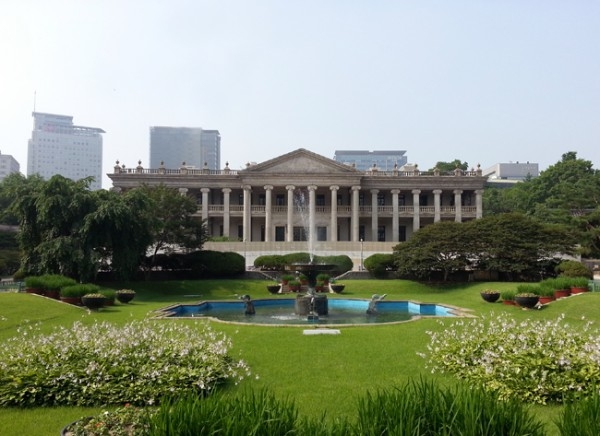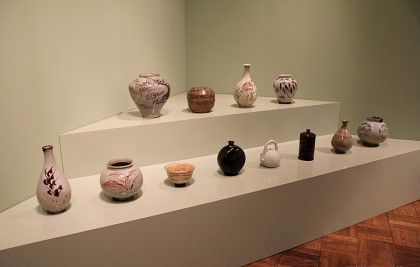
July 16 2013 Sunshine Lee's Culture Essay Beauty of Sorrow My friends and I agreed that we would have lunch together and go see an exhibition at Deoksugung Palace. Everyone agreed, yet after chattering till 4 p.m. everyone left. I walked along the stone wall alone. I was able to enter Deoksugung Palace only after pushing my way through a large number of police officers trying to control protestors.
It had been a long time.
The name Deoksu is familiar to me, as I went to Deoksu elementary school behind Deoksugung Palace. I lived at my grandmother’s when I was young. I remember taking a picture with my mother at Deoksugung Palace with peony blossom in full bloom; I was delighted to see my young mother after such a long time. These memories come to me as I walk in front of Deoksugung Palace.
Deoksugung Palace used to be a residence of King Gojong. It later became the Yi Royal Family Museum, and finally the National Museum of Modern and Contemporary Art (MMCA) in 1973. My uncle who served a long time as the director of the Ministry of Culture and Information was also a director of the MMCA. I visited him in MMCA once; Deoksugung Palace holds many dear memories of mine.
This time, I visited Deoksugung Palace to see a collections exhibition of Yanagi Muneyoshi, a famous Japanese collector. I once read that he loved Joseon art and collected folk crafts.
I had been curious what else he did besides collect, but this was due to my ignorance, regarding collecting as a mere hobby. I realized today that collecting extensively across the East and the West, studying, preserving and maintaining the artifacts and writing are all great acts of ‘creating’ and ‘creative collecting’.
In 1914, Yanagi Muneyoshi received Joseon pottery from Asakawa Noritaka, a Japanese friend living in Joseon. He was captivated by the charm of the Joseon pottery – in fact he held too much respect for the Joseon people who made them that he started collecting 2,000 pieces of Joseon’s artifacts – and collected 20,000 pieces of other countries’ artifacts. The pottery was not fine white porcelain; rather, he collected plain pottery and common crafts that folks used. No one cared about them back then. His pioneering aesthetic sense that recognized their beauty is surprising even to this day.
There was no concept like “folk arts” at the time he lived. Yet he tried leading the creation of tomorrow through the value of ordinary things used in the area he lived. He marveled at ‘line’ of Joseon and felt ‘the sadness permeating Joseon’s beauty’ – he dubbed it the ‘beauty of sorrow’.
He was worried that the superior culture of Joseon people was fading away; so worried that he decided to build a museum on behalf of the Joseon people. He thought that was the way to return the favor that he enjoyed from the art of Joseon.
He built the Joseon People’s Museum at Gyongbokgung Palace. The Japanese Government General of Korea ordered that the word “people” be erased from its name, but he didn’t comply.
One time, a friend of mine who was from the U.K. told me while looking at the statute of Admiral Nelson in the middle of Trafalgar Square that Nelson was the second best Admiral in the world – the best being Yi Sun-sin. I didn’t know that the world thought Yi Sun-sin was the best admiral ever. Moreover, this was 30 years ago when Europe didn’t know about Korea at all. I was told that the Japanese studied the invincible admiral Yi Sun-sin and had made him known to the world.
The Japanese study an admiral from a foreign country that kept beating their own country. I hope Koreans also study and learn from Japanese people and outstand their achievements.
I, for my part, was inspired by Yanagi Muneyoshi’s achievements across his short life of 70 years. I would like to study how he came to achieve such superior aesthetic sense and didn’t stop at collecting, but proceeded to study, write and make ‘the philosophy on the beauty of sorrow’ known to the world.
To me, True beauty is God.

Western style modern architecture designed by Harding, British in 1898  The MMCA with Yanagi Muneyoshi’s Joseon folk collections on display July 2013 

Joseon’s pattern ruler and reel – Yanagi was the first to come up with the concept of ‘folk arts’
| 









